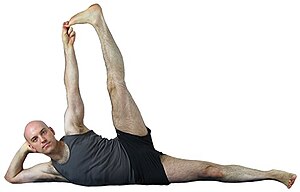Anantasana (Sanskrit: अनन्तासन; IAST: Anantāsana), Sleeping Vishnu Pose or Vishnu's Couch Pose,[1] Eternal One's Pose, or Side-Reclining Leg Lift[2] is an asana in modern yoga as exercise.

Etymology and origins
editThe name comes from the Sanskrit words anantā (अनन्त) meaning "without end" or "the infinite one", for the thousand-headed serpent Shesha upon which Vishnu rested at the bottom of the primordial ocean,[3] and āsana (आसन) meaning "posture" or "seat".[4]
A different reclining pose named Anantasana is described and illustrated in the 19th century Sritattvanidhi.[5] The modern pose is described in the 1966 Light on Yoga.[3]
Description
editAnantasana is entered from a lying position. The head is supported with one hand, the upper arm on the ground on that side; the other hand and leg are stretched straight up, the fingers grasping the big toe of the raised foot. The supporting arm, body, and lower leg are in a straight line.[2]
See also
editReferences
edit- ^ "Anantasana". Yoga Journal. Retrieved 28 January 2019.
- ^ a b "Side-Reclining Leg Lift". Yoga Journal. 3 June 2008.
- ^ a b Iyengar, B. K. S. (1977) [1966]. Light on yoga: yoga dipika. Schocken Books. p. 246. ISBN 978-0-8052-1031-6.
- ^ Sinha, S. C. (1 June 1996). Dictionary of Philosophy. Anmol Publications. p. 18. ISBN 978-81-7041-293-9.
- ^ Sjoman, Norman E. (1999) [1996]. The Yoga Tradition of the Mysore Palace (2nd ed.). Abhinav Publications. pp. 69 and plate 1 (pose 1). ISBN 81-7017-389-2.[permanent dead link]
Further reading
edit- Saraswati, Swami Satyananda (2003). Asana Pranayama Mudra Bandha. Nesma Books India. ISBN 978-81-86336-14-4.